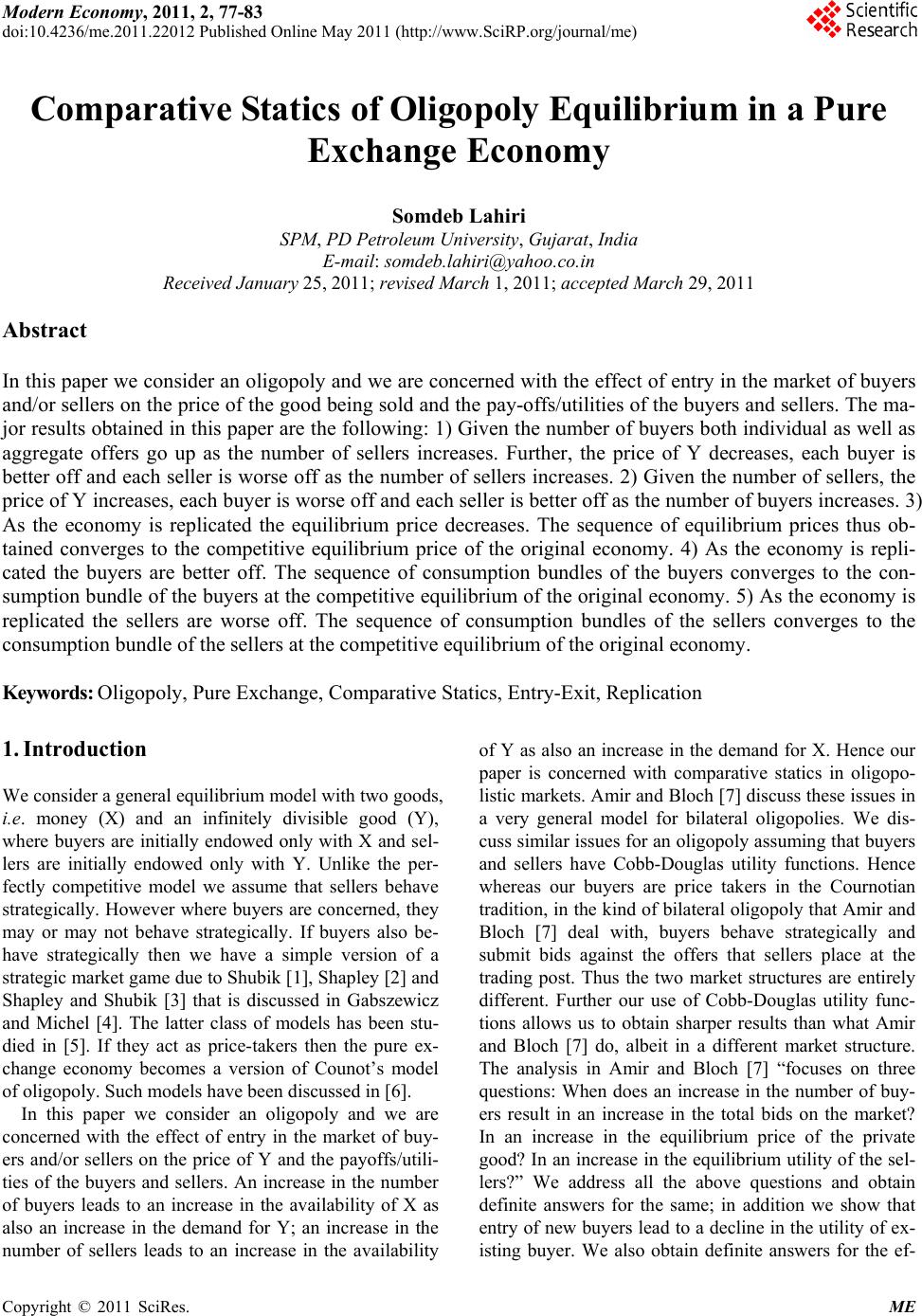 Modern Economy, 2011, 2, 77-83 doi:10.4236/me.2011.22012 Published Online May 2011 (http://www.SciRP.org/journal/me) Copyright © 2011 SciRes. ME Comparativ e Statics of Oligopoly Equilibrium in a Pure Exchange Economy Somdeb Lahiri SPM, PD Petroleum University, Gujarat, India E-mail: somdeb.lahiri@yahoo.co.in Received January 25, 2011; revised March 1, 2011; accepted March 29, 2011 Abstract In this paper we consider an oligopoly an d we are concerned with the effect o f entry in the market of buyers and/or sellers on the price of the good being sold and the pay-offs/utilities of t he buyers and seller s. The ma- jor results obtained in this paper are the following: 1) Given the number of buyers both individual as well as aggregate offers go up as the number of sellers increases. Further, the price of Y decreases, each buyer is better off and each seller is worse off as the n umber of sellers incr eases. 2) Given the number of sellers, the price of Y increases, each buy er is worse o ff and each seller is b etter off as th e number of buyers in creases. 3) As the economy is replicated the equilibrium price decreases. The sequence of equilibrium prices thus ob- tained converges to the competitive equilibrium price of the original economy. 4) As the economy is repli- cated the buyers are better off. The sequence of consumption bundles of the buyers converges to the con- sumption bundle of the buyers at the competitive equilibrium of the original economy. 5) As the economy is replicated the sellers are worse off. The sequence of consumption bundles of the sellers converges to the consumption bundle of the sellers at the competitive equilibrium of the original economy. Keywords: Oligopoly, Pure Exchange, Comparative Statics, Entry-Exit, Replication 1. Introduction We consider a general equilibrium model with two goods, i.e. money (X) and an infinitely divisible good (Y), where buyers are initially endowed only with X and sel- lers are initially endowed only with Y. Unlike the per- fectly competitive model we assume that sellers behave strategically. However where buyers are concerned, they may or may not behave strategically. If buyers also be- have strategically then we have a simple version of a strategic market game due to Shubik [1], Shapley [2] and Shapley and Shubik [3] that is discussed in Gabszewicz and Michel [4]. The latter class of models has been stu- died in [5]. If they act as price-takers then the pure ex- change economy becomes a version of Counot’s model of oligopoly. Such models have been discussed in [6]. In this paper we consider an oligopoly and we are concerned with the effect of entry in the market of buy- ers and/or sellers on the price of Y and the payoffs/utili- ties of the buyers and sellers. An increase in the number of buyers leads to an increase in the availability of X as also an increase in the demand for Y; an increase in the number of sellers leads to an increase in the availability of Y as also an increase in the demand for X. Hence our paper is concerned with comparative statics in oligopo- listic markets. Amir and Bloch [7] discuss these issues in a very general model for bilateral oligopolies. We dis- cuss similar issues for an oligopoly assuming that buyers and sellers have Cobb-Douglas utility functions. Hence whereas our buyers are price takers in the Cournotian tradition, in the kind of bilateral oligo poly that Amir and Bloch [7] deal with, buyers behave strategically and submit bids against the offers that sellers place at the trading post. Thus the two market structures are entirely different. Further our use of Cobb-Douglas utility func- tions allows us to obtain sharper results than what Amir and Bloch [7] do, albeit in a different market structure. The analysis in Amir and Bloch [7] “focuses on three questions: When does an increase in the number of buy- ers result in an increase in the total bids on the market? In an increase in the equilibrium price of the private good? In an increase in the equilibrium utility of the sel- lers?” We address all the above questions and obtain definite answers for the same; in addition we show that entry of new buyers lead to a decline in the utility of ex- isting buyer. We also obtain definite answers for the ef- 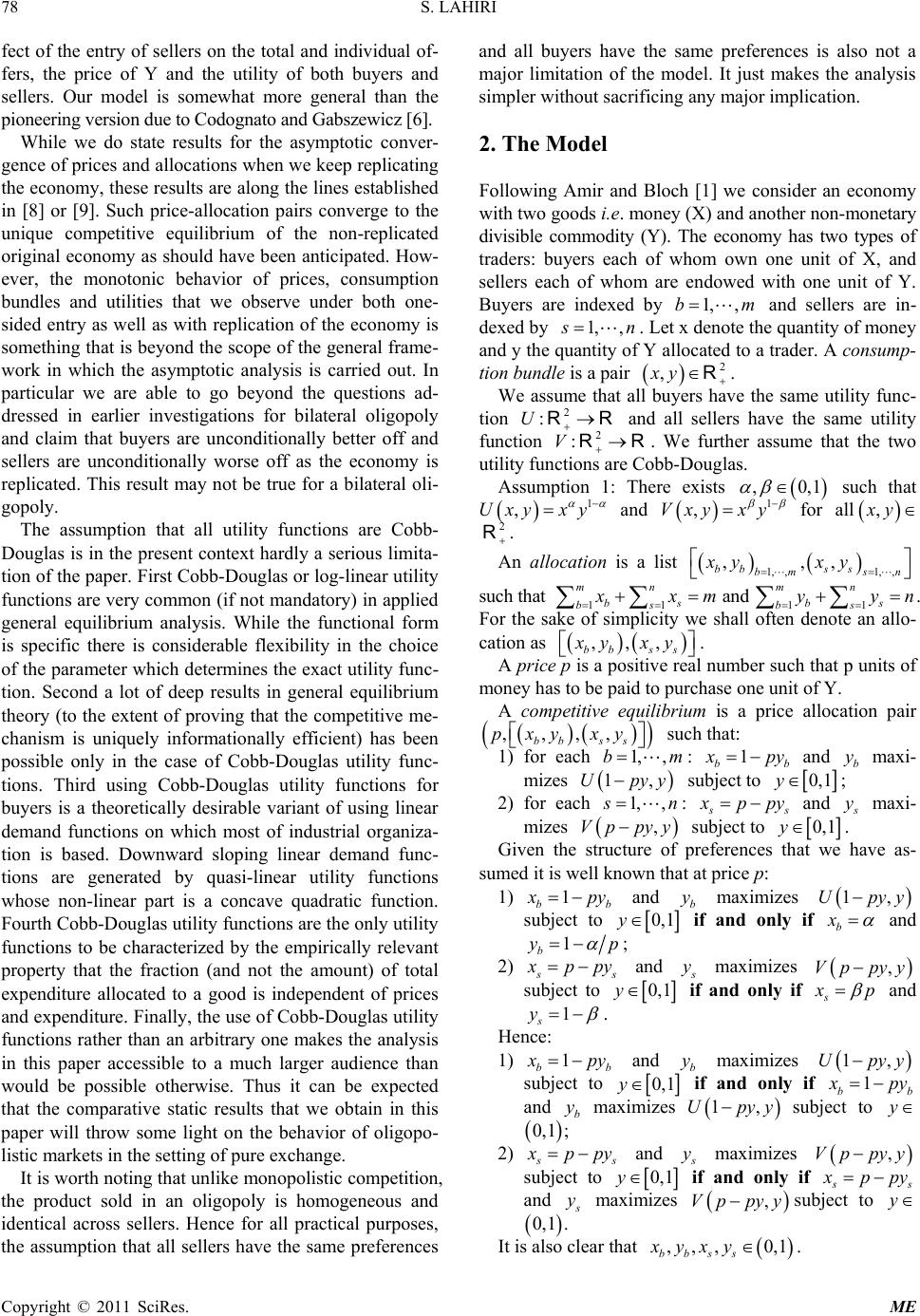 S. LAHIRI Copyright © 2011 SciRes. ME fect of the entry of sellers on the total and individual of- fers, the price of Y and the utility of both buyers and sellers. Our model is somewhat more general than the pioneering ve rsi on due t o Codogna to a nd Ga bsz ewi cz [6]. While we do state results for the asymptotic conver- gence of prices and allocations when we keep replicating the economy, these results are along the lines established in [8] or [9]. Such price-allocation pairs converge to the unique competitive equilibrium of the non-replicated original economy as should have been anticipated. How- ever, the monotonic behavior of prices, consumption bundles and utilities that we observe under both one- sided entry as well as with replication of the economy is something that is beyond the scope of the general frame- work in which the asymptotic analysis is carried out. In particular we are able to go beyond the questions ad- dressed in earlier investigations for bilateral oligopoly and claim that buyers are unconditionally better off and sellers are unconditionally worse off as the economy is replicated. This result may not be true for a bilateral oli- gopoly. The assumption that all utility functions are Cobb- Douglas is in the pres ent context hardly a serious limita- tion of the paper. First Cobb-Douglas or log-linear u tility functions are very common (if not mandatory) in applied general equilibrium analysis. While the functional form is specific there is considerable flexibility in the choice of the parameter which determines the exact utility fun c- tion. Second a lot of deep results in general equilibrium theory (to the extent of proving that the competitive me- chanism is uniquely informationally efficient) has been possible only in the case of Cobb-Douglas utility func- tions. Third using Cobb-Douglas utility functions for buyers is a theoretically desirable variant of using linear demand functions on which most of industrial organiza- tion is based. Downward sloping linear demand func- tions are generated by quasi-linear utility functions whose non-linear part is a concave quadratic function. Fourth Cobb-Douglas utility functions are the only utility functions to be characterized by the empirically relevant property that the fraction (and not the amount) of total expenditure allocated to a good is independent of prices and expenditure. Finally, the use of Cobb-Douglas utility functions rather than an arbitrary one makes the analysis in this paper accessible to a much larger audience than would be possible otherwise. Thus it can be expected that the comparative static results that we obtain in this paper will throw some light on the behavior of oligopo- listic markets in the setting of pure exchange. It is worth noting that unlike monopolistic competition, the product sold in an oligopoly is homogeneous and identical across sellers. Hence for all practical purposes, the assumption that all sellers have the same preferences and all buyers have the same preferences is also not a major limitation of the model. It just makes the analysis simpler without sacrif icing any major implication. 2. The Model Following Amir and Bloch [1] we consider an economy with two goods i.e. money (X) and another non-monetary divisible commodity (Y). The economy has two types of traders: buyers each of whom own one unit of X, and sellers each of whom are endowed with one unit of Y. Buyers are indexed by and sellers are in- dexed by . Let x d enote the quantity of money and y the quantity of Y allocated to a trader. A consump- tion bundle is a pair ( ) 2 ,xy + ∈R. We assume that all buyers have the same utility func- tion and all sellers have the same utility function . We further assume that the two utility functions are Cobb-Douglas. Assumption 1: There exists , 0,1 αβ ∈ such that and for all . An allocation is a list ()( ) 1, ,1, , , ,, bb ss bm sn xy xy = = such that 11 11 and mn mn bs bs bs bs x xmyyn = === += += ∑∑ ∑∑ . For the sake of simplicity we shall often denote an allo- cation as () () , ,, bb ss xy xy . A price p is a positive real number s uch that p units of money has to be paid to purchase one unit of Y. A competitive equilibrium is a price allocation pair () () ,, ,, bb ss p xyxy such that: 1) for each : 1 x py= − and b y maxi- mizes subject to ; 2) for each : xp py= − and s y maxi- mizes ,Vppy y− subject to 0, 1y∈. Given the structure of preferences that we have as- sumed it is well known that at price p: 1) 1 x py= − and b y maximizes subject to 0, 1y∈ if and only if and ; 2) xp py= − and s y maxi mi zes ,Vppy y− subject to 0, 1y∈ if and only if s β = and s β = −. Hence: 1) 1 x py= − and b y maximizes subject to 0, 1y∈ if and only if 1 x py= − and maximizes subject to ; 2) xp py= − and s y maximizes ,Vppy y− subject to 0, 1y∈ if and only if = − and s y maximizes subject to . It is also clear that . 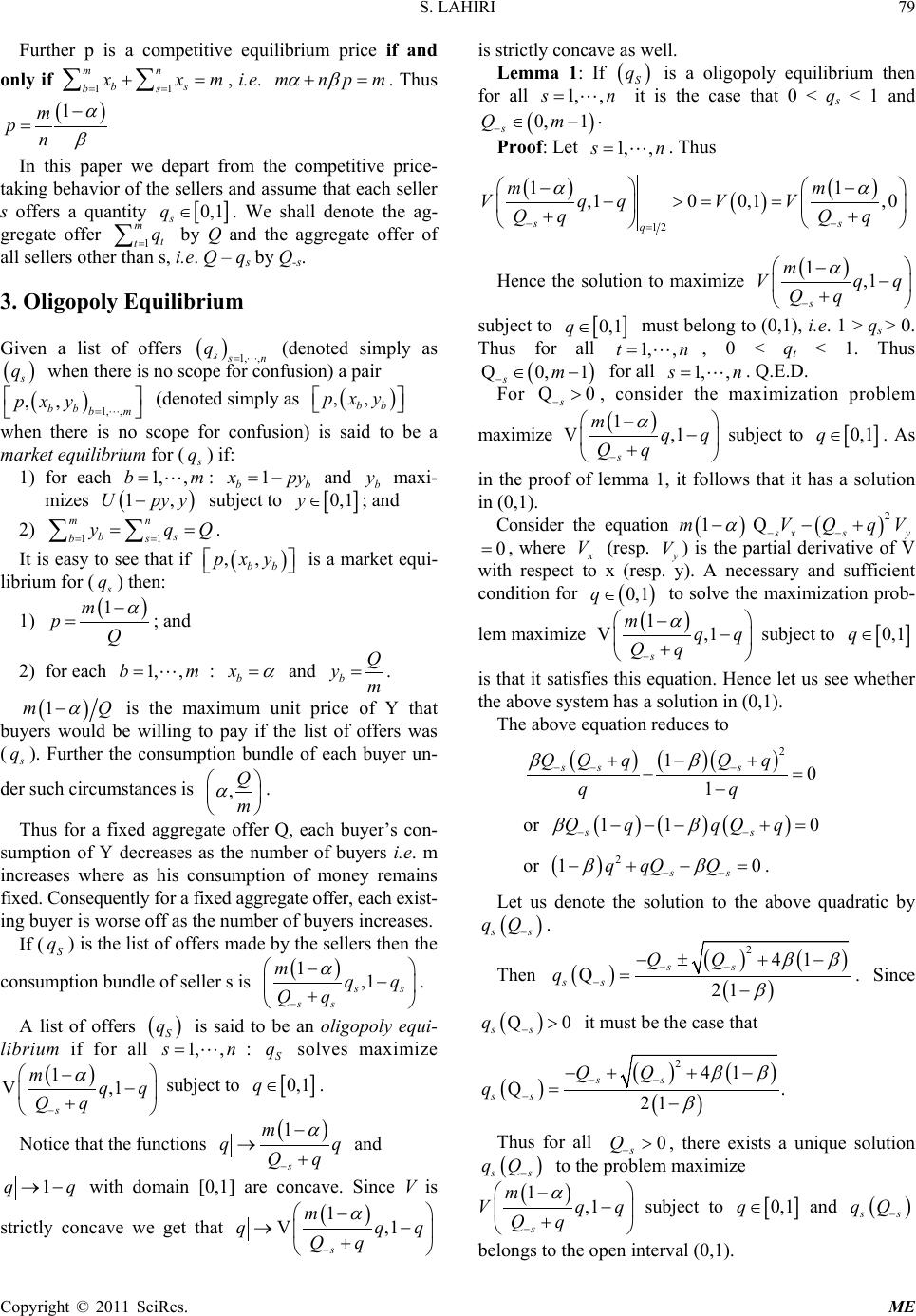 S. LAHIRI Copyright © 2011 SciRes. ME Further p is a competitive equilibrium price if and only if , i.e. . Thus 1 m pn α β − = In this paper we depart from the competitive price- taking behavior of the sellers and assume that each seller s offers a quantity . We shall denote the ag- gregate offer 1 m t tq = ∑ by Q and the aggregate offer of all sellers other than s, i.e. Q – qs by Q-s. 3. Oligopoly Equilibrium Given a list of offers 1, , s q= (denoted simply as when there is no scope for confusion) a pair ( ) 1, , ,, bb pxy = (denoted simply as when there is no scope for confusion) is said to be a market equilibrium for (s q) if: 1) for each : 1 x py= − and b y maxi- mizes subject to ; and 2) . It is easy to see that if is a market equi- librium for (s q) then: 1) 1m pQ α − =; and 2) for each : and . 1 α − is the maximum unit price of Y that buyers would be willing to pay if the list of offers was (s q). Further the consumption bundle of each buyer un- der such circumstances is ,Q m α . Thus for a fixed aggregate offer Q, each buyer’s con- sumption of Y decreases as the number of buyers i.e. m increases where as his consumption of money remains fixed. Conse qu e ntly for a fixed aggregate offer, each exist- ing buyer is worse off as the number of buyers increases. If (S q) is the list of offers made by the sellers then the consum ption bundl e of se l ler s is ( ) 1,1 ss ss mqq Qq α − − − + . A list of offers S q is said to be an oligopoly equi- librium if for all : S q solves maximize ( ) 1 V ,1 s mqq Qq α − − − + subject to 0, 1q∈. Notice that the functions and 1 →− with domain [0,1] are concave. Since V is strictly concave we get that 1 V ,1 s m q qq Qq α − − + is strictly concave as well. Lemma 1: If is a oligopoly equilibrium then for all it is the case that 0 < qs < 1 and 0, 1 s − . Proof: Let . Thus ( )( )( ) 12 ,10 0,1,0 q VqqV V Qq Qq = − >== Hence the solution to maximize 1,1 s m V qq Qq α − − − + subject to must belong to (0,1), i.e. 1 > qs > 0. Thus for all , 0 < qt < 1. Thus Q0, 1 sm − for all . Q.E.D. For s−>, consider the maximization problem maximize ( ) 1 V ,1 s mqq Qq α − − − + subject to 0, 1q∈. As in the proof of lemma 1, it follows that it has a solution in (0,1). Consider the equation ( ) ( ) 2 1 Q sx sy mV QqV α −− − −+ , where x V (resp. ) is the partial derivative of V with respect to x (resp. y). A necessary and sufficient condition for 0, 1q∈ to solve the maximization prob- lem ma xi mi z e ( ) 1 V ,1 s mqq Qq α − − − + subject to 0, 1q∈ is that it satisfies this equation. Hence let us see whether the above system has a solution in (0,1). The above equation reduces to ( ) ( ) ( ) 2 10 1 ss s QQq Qq −− − +− + − or 11 0 QqqQ q − −−+= or 2 q qQQ . Let us denote the solution to the above quadratic by qQ −. Then ( )( ) ( ) ( ) 2 41 Q21 ss ss QQ q ββ β −− − −±+ − =− . Since it must be the case that ( )( ) ( ) ( ) 2 41 Q21 ss ss QQ q ββ β −− − −++ − =− . Thus for all s − , there exists a unique solution qQ − to the problem maximize ( ) 1,1 s m V qq Qq α − − − + subject to 0, 1q∈ and belongs to the open interval (0,1). 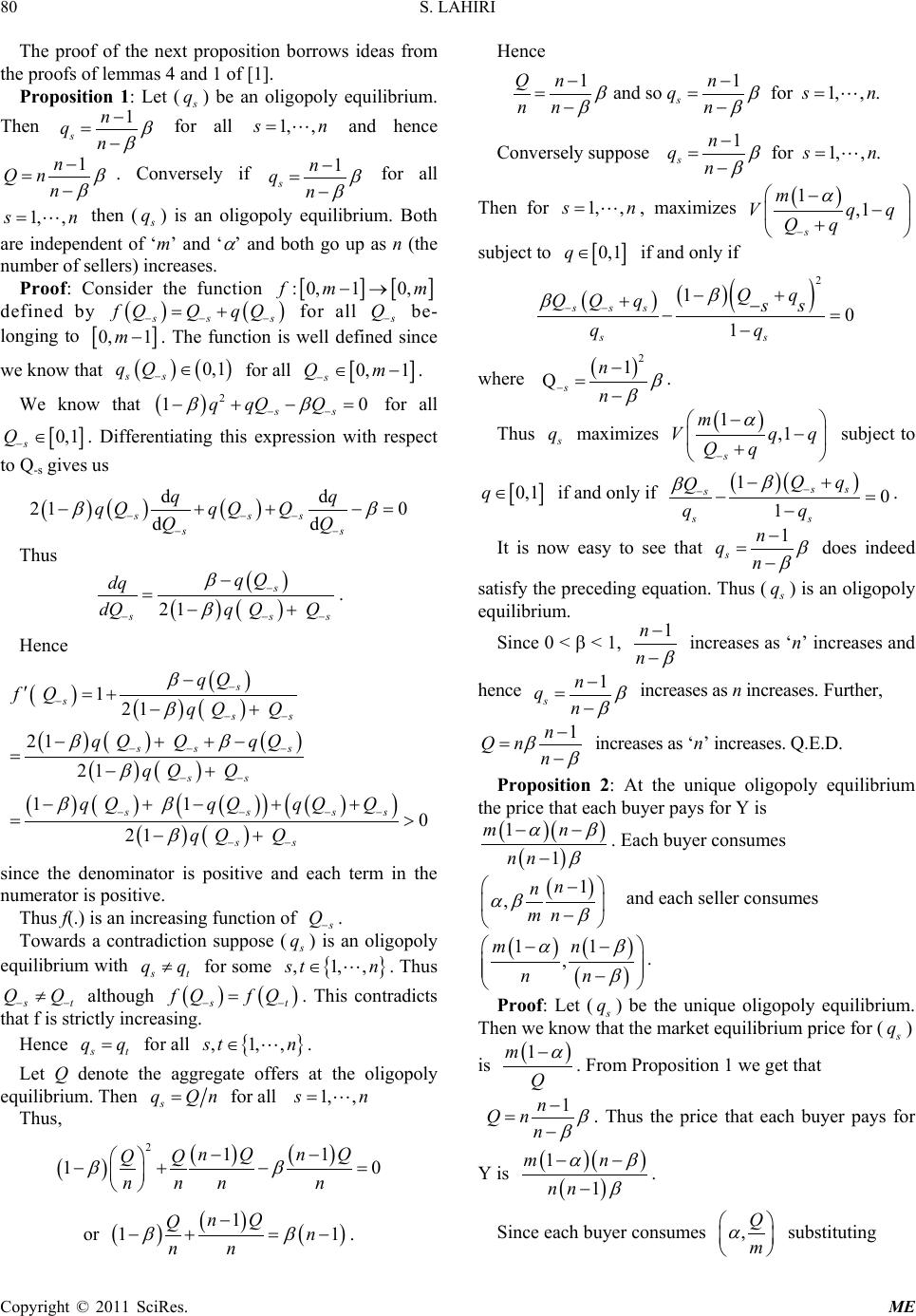 S. LAHIRI Copyright © 2011 SciRes. ME The proof of the next proposition borrows ideas from the proofs of lemmas 4 and 1 of [1]. Proposition 1: Let (s ) be an oligopoly equilibrium. Then for all and hence . Conversely if for all then (s q) is an oligopoly equilibrium. Both are independent of ‘m’ and ‘ α ’ and both go up as n (the number of sellers) increases. Proof: Consider the function defined by for all s − be- longing to . The function is well defined since we know that for all 0, 1 s − . We know that 2 q qQQ for all 0, 1 s Q−∈. Differentiating this expression with respect to Q-s gives us ( ) ( )( ) dd 21 0 dd s ss ss qq qQqQ Q QQ ββ − −− −− −+ +−= Thus ( ) ( ) ( ) 21 s s ss qQ dq dQq QQ β β − − −− − =−+ . Hence ( ) ( ) ( ) ( ) ()( ) ( ) ( ) ( ) ()( ) ( ) ( ) ( ) ( ) ( ) 121 21 21 1 10 21 s sss ss s ss ss ss ss qQ fQ qQ Q q QQqQ qQ Q q QqQqQQ qQ Q β β ββ β ββ β − − −− −− − −− −− −− −− − ′= +−+ −++− =−+ −+− + + = > −+ since the denominator is positive and each term in the numerator is positive. Thus f(.) is an increasing function of s Q−. Towards a contradiction suppose (s q) is an oligopoly equilibrium with for some ,1, ,st n∈. Thus ≠ although . This contradicts that f is strictly increasing. Hence for all ,1, ,st n∈. Let Q denote the aggregate offers at the oligopoly equilibrium. Then s q Qn= for all Thus, ( ) 2 nQ nQ QQ n nnn or () ( )( ) 1 11 nQ Qn nn ββ − −+ =− . Hence and so for 1,,. s q sn nn n == = −− Conversely suppose 1 for 1,,. s n q sn n β β − = = − Then for , maximizes ( ) 1,1 s m V qq Qq α − − − + subject to if and only if ( ) ( ) ( ) 2 10 1 s ss ss Qq QQ qss qq β β −− −+ +− −= − where . Thus s q maximizes ( ) 1,1 s m V qq Qq α − − − + subject to 0, 1q∈ if and only if ( ) ( ) 10 1 ss s ss Qq Q qq β β − −−+ −= − . It is now easy to see that does indeed satisfy the p receding equation. Thus (s q) is an oligopoly equilibrium. Since 0 < β < 1, increases as ‘n’ increases and hence i ncreases as n increases. Further, i ncreases as ‘n’ increase s. Q.E.D. Proposition 2: At the unique oligopoly equilibrium the price that each buyer pa ys for Y is . Each buyer consumes and each seller consumes () () ( ) 11 , mn nn αβ β −− − . Proof: Let (s q) be the unique oligopoly equilibrium. Then we kn o w that the market equilibrium price for (s q) is . From Proposition 1 we get that Qn n β β =− . Thus the price that each buyer pays for Y is ( ) 1 1 nn β −. Since each buyer consumes substituting 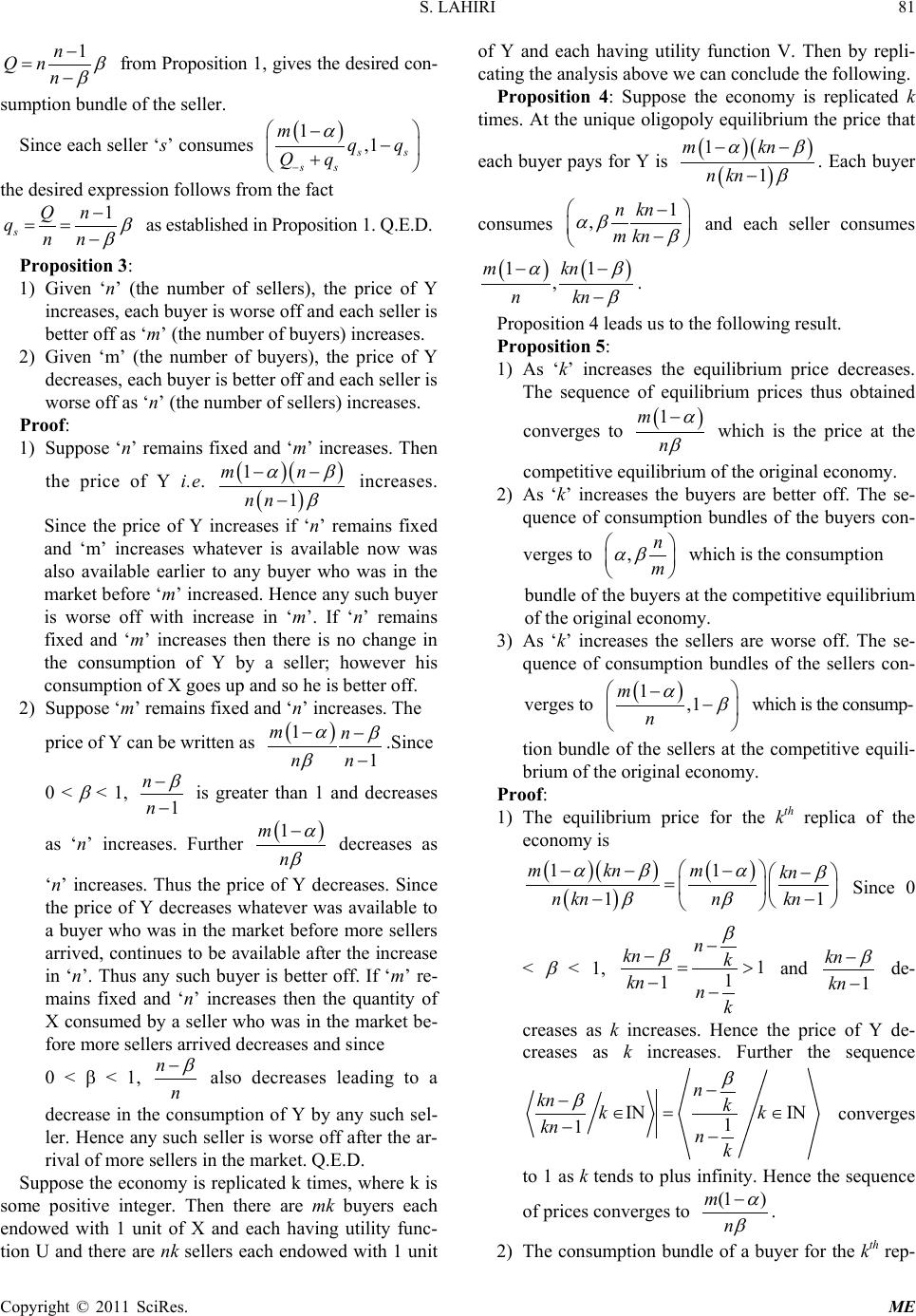 S. LAHIRI Copyright © 2011 SciRes. ME 1n Qn n β β − =− from Proposition 1, gives the desired con- sumption bundle of the seller. Since each seller ‘s’ consumes 1,1 ss m Qq α − − − + the desired expression follows from th e f act 1 s qnn β β − ==− as establi shed in P roposi ti on 1. Q.E.D. Proposit ion 3: 1) Given ‘n’ (the number of sellers), the price of Y increases, each buyer is worse off and each seller is better off as ‘m’ (the number of buy e rs) incr e a se s . 2) Given ‘m’ (the number of buyers), the price of Y decreases, each buyer is better off and each seller is worse off as ‘n’ (the number of se l lers) increases. Proof: 1) Suppose ‘n’ remains fixed and ‘m’ increases. Then the price of Y i.e. increases. Since the price of Y increases if ‘n’ remains fixed and ‘m’ increases whatever is available now was also available earlier to any buyer who was in the market before ‘m’ increased. Hence any such buyer is worse off with increase in ‘m’. If ‘n’ remains fixed and ‘m’ increases then there is no change in the consumption of Y by a seller; however his consumption of X goes up and so he is better off. 2) Suppose ‘m’ remains fixed and ‘n’ increases. The price of Y can be written as .Since 0 < β < 1, is greater than 1 and decreases as ‘n’ increases. Further decreases as ‘n’ increases. Thus the price of Y decreases. Since the price of Y decreases whatever was available to a buyer who was in the market before more sellers arrived, continues to be available after the increase in ‘n’. Thus any such buyer is better off. If ‘m’ re- mains fixed and ‘n’ increases then the quantity of X consumed by a seller who was in the market be- fore more sellers arrived decreases and since 0 < β < 1, also decreases leading to a decrease in the consumption of Y by any such sel- ler. Hence any such seller is worse off after the ar- rival of more sellers in the market. Q.E.D. Suppose the economy is replicated k times, where k is some positive integer. Then there are mk buyers each endowed with 1 unit of X and each having utility func- tion U and there are nk sellers each endowed with 1 unit of Y and each having utility function V. Then by repli- cating the analysis above we can conclude the following. Proposition 4: Suppose the economy is replicated k times. At the unique oligopoly equilibrium the price that each buyer pays for Y is . Each buyer consumes 1 ,n kn m kn αβ β − − and each seller consumes , m kn n kn β −. Proposition 4 leads us to the following result. Proposit ion 5: 1) As ‘k’ increases the equilibrium price decreases. The sequence of equilibrium prices thus obtained converges to 1m n α β − which is the price at the competitive equilibrium of the origina l economy. 2) As ‘k’ increases the buyers are better off. The se- quence of consumption bundles of the buyers con- verges to ,n m αβ which is the consumption bundle of the buyers at the competitive equilibrium of the ori gi na l economy. 3) As ‘k’ increases the sellers are worse off. The se- quence of consumption bundles of the sellers con- verges to 1,1 m n αβ − − which is the consump- tion bundle of the sellers at the competitive equili- brium of the original economy. Proof: 1) The equilibrium price for the kth replica of the economy is ( )() ( ) ( ) m knmkn n knnkn αβα β ββ −− − − = Since 0 < β < 1, and β − − de- creases as k increases. Hence the price of Y de- creases as k increases. Further the sequence IN IN 1 1 n kn k kk kn nk β β − −∈= ∈ −− converges to 1 as k tends to plus infinity. Hence the sequence of prices converges to n β . 2) The consumption bundle of a buyer for the kth rep- 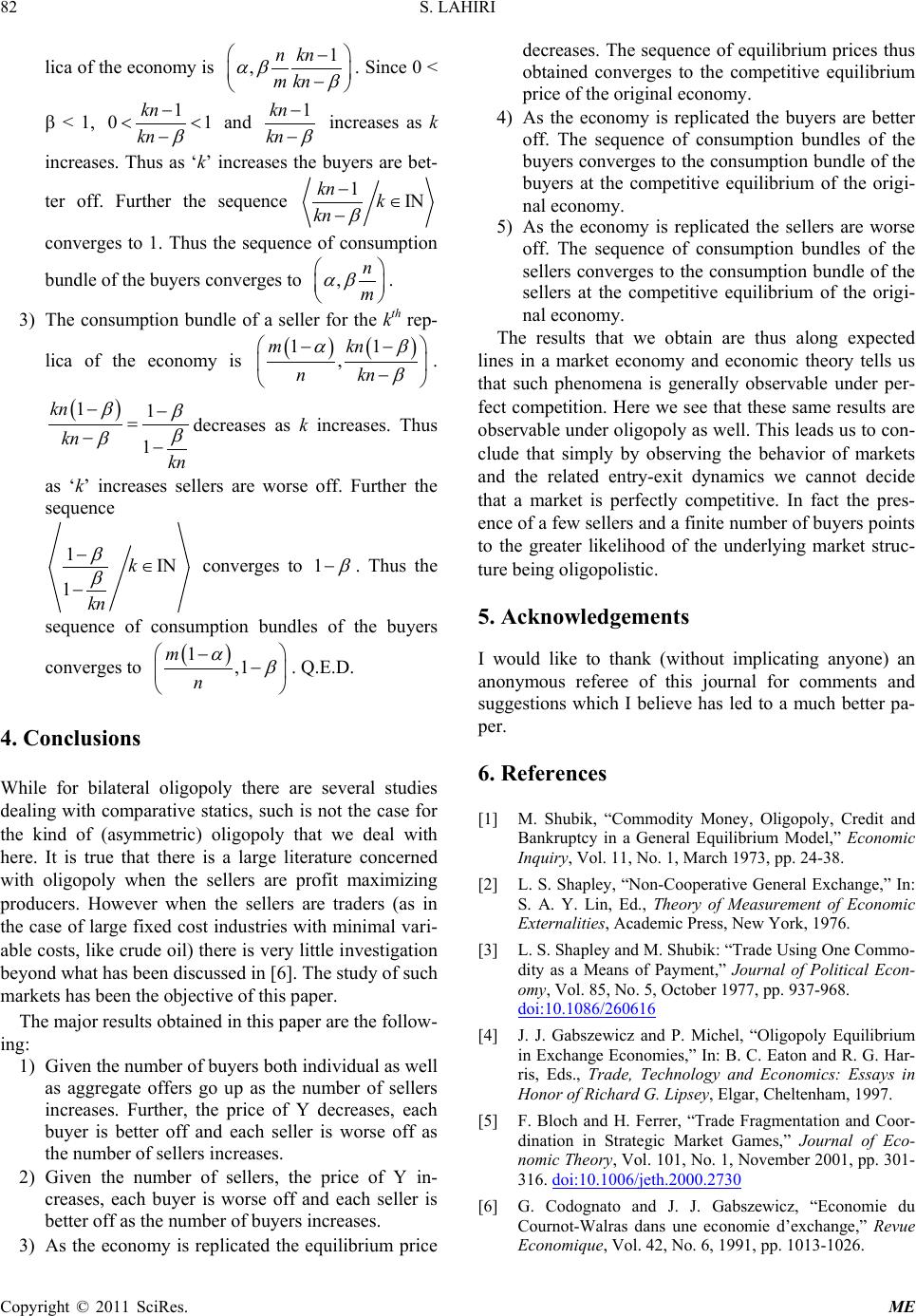 S. LAHIRI Copyright © 2011 SciRes. ME lica of the economy is 1 ,n kn m kn αβ β − − . Since 0 < β < 1, 1 kn β − − and 1 kn β − − increases as k increases. Thus as ‘k’ increases the buyers are bet- ter off. Further the sequence converges to 1. Thus the sequence of consumption bundle of the buyer s converges to . 3) The consumption bundle of a seller for the kth rep- lica of the economy is , m kn n kn β − . 11 1 kn kn kn ββ β β −− = −− decreases as k increases. Thus as ‘k’ increases sellers are worse off. Further the sequence 1IN 1k kn β β −∈ − converges to . Thus the sequence of consumption bundles of the buyers converges to . Q.E.D. 4. Conclusions While for bilateral oligopoly there are several studies dealing with comparative statics, such is not the case for the kind of (asymmetric) oligopoly that we deal with here. It is true that there is a large literature concerned with oligopoly when the sellers are profit maximizing producers. However when the sellers are traders (as in the case of large fixed cost industries with minimal vari- able costs, like crude oil) there is very little i nvestigation beyond what has been discussed in [6]. The study of such markets has been the objective of this paper. The major results obtained in this paper are the follow- ing: 1) Given the number of buyers both individua l a s w e ll as aggregate offers go up as the number of sellers increases. Further, the price of Y decreases, each buyer is better off and each seller is worse off as the number of sellers inc reases. 2) Given the number of sellers, the price of Y in- creases, each buyer is worse off and each seller is better off as the number of buyers increases. 3) As the economy is replicated the equilibrium price decreases. The sequence of equilibrium prices thus obtained converges to the competitive equilibrium price of the o riginal ec onomy. 4) As the economy is replicated the buyers are better off. The sequence of consumption bundles of the buyers converges to the consumption bundle of the buyers at the competitive equilibrium of the origi- nal economy. 5) As the economy is replicated the sellers are worse off. The sequence of consumption bundles of the sellers converges to the consumption bundle of the sellers at the competitive equilibrium of the origi- nal economy. The results that we obtain are thus along expected lines in a market economy and economic theory tells us that such phenomena is generally observable under per- fect competition. Here we see that these same results are observable under oligopoly as well. This leads us to con- clude that simply by observing the behavior of markets and the related entry-exit dynamics we cannot decide that a market is perfectly competitive. In fact the pres- ence of a few sellers and a finite number of buyers points to the greater likelihood of the underlying market struc- ture being oligopolistic. 5. Acknowledgements I would like to thank (without implicating anyone) an anonymous referee of this journal for comments and suggestions which I believe has led to a much better pa- per. 6. References [1] M. Shubik, “Commodity Money, Oligopoly, Credit and Bankruptcy in a General Equilibrium Model,” Economic Inquiry, Vol. 11, No. 1, March 1973, pp. 24-38. [2] L. S. Shapley, “Non-Cooperative General Exchange,” In: S. A. Y. Lin, Ed., Theory of Measurement of Economic Externalities, Academic Press, New York, 1976. [3] L. S. Shapley and M. Shubik: “Trade Using One Commo- dity as a Means of Payment,” Journal of Political Econ- omy, Vol. 85, No. 5, October 1977, pp. 937-968. doi:10.1086/260616 [4] J. J. Gabszewicz and P. Michel, “Oligopoly Equilibrium in Exchange Economies,” In: B. C. Eaton and R. G. Har- ris, Eds., Trade, Technology and Economics: Essays in Honor of Richard G. Lipsey, Elgar, Cheltenham, 1997. [5] F. Bloch and H. Ferrer, “Trade Fragmentation and Coor- dination in Strategic Market Games,” Journal of Eco- nomic Theory, Vol . 101, No. 1, November 2001, pp. 301- 316. doi:10.1006/jeth.2000.2730 [6] G. Codognato and J. J. Gabszewicz, “Economie du Cournot-Walras dans une economie d’exchange,” Revue Economique, Vol. 42, No. 6, 1991, pp. 1013-1026.  S. LAHIRI Copyright © 2011 SciRes. ME [7] R. Amir and F. Bloch: “Comparative Statics in a Simple Class of Strategic Market Games,” Games and Economic Behavior, Vol. 65, No. 1, 2009, pp. 7-24. doi:10.1016/j.geb.2007.09.002 [8] S. Lahiri, “Asymptotic Convergence to Competitive Equilibrium of Oligopoly Equilibria,” 2010. http://papers.ssrn.com/sol3/papers.cfm?abstract_id=1739 486 [9] R. Lahmandi-Ayed, “Oligopoly Equilibria in Exchange Economies: A Limit Theorem,” Economic Theory, Vol. 17, No. 3, 2001, pp. 665-674. doi:10.1007/PL00004122
|